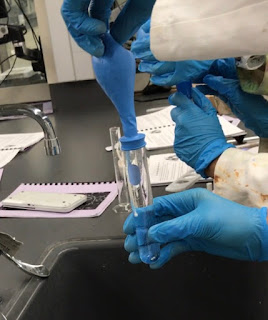Lab 18: Alka Seltzer and the Ideal Gas Law Lab
Alka Seltzer and the Ideal Gas Law Lab
Introduction:
The purpose of this lab was to determine the mass of carbon dioxide released when a sample of alka seltzer is placed in water. This was done by collecting the gas in a balloon and measuring its dimensions after the reaction. This would allow us to get an estimate of about how much volume of gas was in the balloon and determine the amount of CO2 given off. We could determine the volume not only by measuring the size of the balloon but also filling the balloon to the same size with water and measuring the amount of water in a graduated cylinder.
(Balloon before alka seltzer put in water) (Balloon after alka seltzer put in water)
Data:
Calculations:
Analysis Questions:
1. Discuss an area in this lab where experimental error may have occurred.
One of the main spots we could have had an experiment al error was when we attempted to fill the balloon with water to the same size it was after the reaction. This was very difficult because water is much heavier so it stretched the balloon into a slightly different shape from the original which could have easily effected the measurement. Also, we just used a string to measure the circumference of the balloon which wasn't exactly a sphere and we just used a string. Another error could have been at the beginning of the lab because we had to transfer the powder from a bowl to the balloon and some of it could have stuck to the bowl or just not make it into the balloon.
2. Choose one error from above and discuss if it would make "n" the number of moles of CO2 too big or too small.
One of the errors I mentioned above was the fact that some of the alka seltzer powder might have not been transferred into the balloon and could have been stuck to the bowl or spilled. This would reduce the moles of CO2 because less powder would be able to react with the water meaning less CO2 could be produced.
3. Filling the balloon with water may be one place where error could have occurred. Using the value for the circumference of the balloon in cm, calculate the volume of the balloon mathematically. Remember that the circumference of a sphere is 2πr and and volume is 4/3πr^3.
4. Compare your answer to #3 to the volume obtained by filling the balloon with water. Is it close? Which do you feel is more accurate and why? Remember that 1cm^3=1mL.
No, the mathematical solution is not very close compared to what we actually got during the experiment and we were almost 200 cm^3/mL away from the tested volume. This makes sense because during the experiment, we did not use very exact processes to calculate the circumference and the amount of water used to fill the balloon could have easily not been exact. This is why I believe the mathematical solution is more accurate.
5. The ideal gas law technically applies to ideal gases. Give two differences between a real gas and an ideal gas. You may use your computer or book to research.
Some differences between a real gas and an ideal gas are that ideal gasses don't have volume, no attractive or repulsive forces and when particles, they still have the same kinetic energy. This, however, is not what the definition of real gasses are. Real gasses do have a very small volume, have slight attractive and repulsive forces and lose kinetic energy when they collide.
6. Would the CO2 you collect in this lab be considered ideal? Why or why not?
The CO2 we collected in this lab would not be considered ideal because ideal gasses are under theoretical conditions with perfect pressure, temperature and without volume. During this lab, we even measured the volume of the gas so there is no way it could be ideal.
Advanced Questions:
1. Using the information provided on the label, and stoichiometry, calculate the mass of CO2 that should be collected per tablet.
2. What percent is the percent yield for the CO2 collected in your sample?
3. CO2 is water soluble. The solubility around room temperature is around 90mL/100mL of water. What effect does this have on your calculated "n" value?
Since CO2 is soluble at room temperature, some of the CO2 would be dissolved in the water and not in the balloon. This would change our "n" value significantly because we couldn't account for all of the CO2 in the water and the balloons circumference would be much smaller than it should have been.
Conclusion:
Overall, this lab was fairly successful but we clearly had some errors during the procedure. We were still able to complete it with relative ease and the calculations were quite simple. The biggest challenge would have probably been trying to measure the amount of water that could fit in the balloon when it was the same size after the reaction.









Comments
Post a Comment